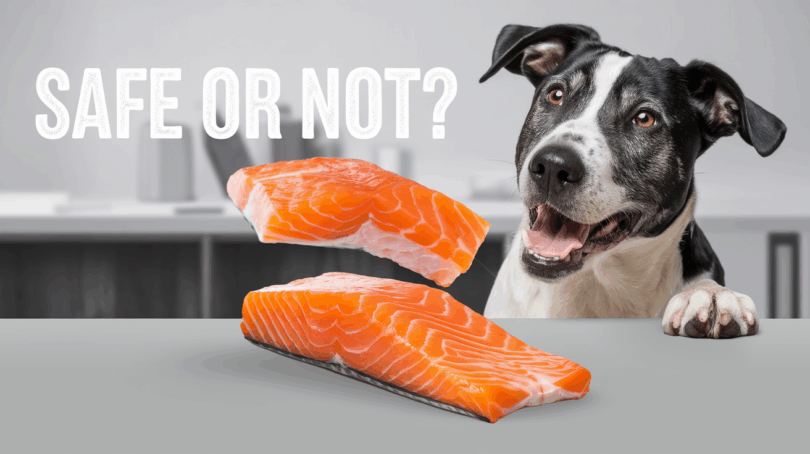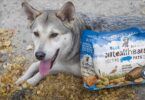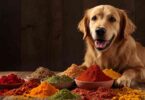What if your furry companion’s diet could gain a boost from an unexpected kitchen staple? Salmon skin often ends up in the trash, but pet owners increasingly wonder whether this omega-rich ingredient might benefit their four-legged friends. Let’s explore the facts.
Properly prepared salmon offers valuable nutrients for pets. Cooked without seasonings or oils, its skin provides high-quality protein and essential fatty acids. These elements support coat shine, joint health, and immune function. However, preparation methods matter significantly for safety.
Raw or undercooked salmon poses risks due to potential parasites. Even when cooked, portions should remain small to avoid digestive upset. Always consult your veterinarian before adding new foods to your pet’s meals—especially if they have existing health conditions.
This article examines scientific insights about salmon as a dietary supplement for dogs. You’ll learn preparation tips, serving guidelines, and how to balance treats with regular nutrition. Our guidance comes from veterinary sources and animal nutrition studies, ensuring reliable advice for your pup’s wellbeing.
Understanding Salmon as a Nutritious Treat for Dogs
Why do so many premium pet foods feature salmon? This flavorful fish offers a powerhouse of nutrients that support vitality in active companions. Over 35% of commercial diets now include it as a primary protein source, according to recent pet nutrition surveys.
Why Salmon Stands Out
Pet owners favor salmon for its mild taste and irresistible aroma, which even picky eaters enjoy. Unlike some seafood, it contains minimal mercury, making it safer for regular use. Veterinarians often recommend it for pets with sensitive stomachs or allergy-prone systems.
Nutrient Profile Overview
A 3-ounce serving delivers 17 grams of muscle-building protein and 1.5 grams of omega-3s. These “good fats” reduce inflammation and promote glossy coats. The fish also provides vitamin B12 for energy metabolism and selenium for immune support.
When prepared plain and fully cooked, salmon becomes a smart occasional addition to meals. Its balanced nutrition complements kibble without disrupting dietary balance. Always consult your vet to determine appropriate portion sizes based on your pet’s weight and activity level.
Nutritional Benefits of Salmon for Your Dog
What makes salmon a standout choice for your pet’s health? This fish delivers a unique combination of nutrients that address multiple aspects of canine wellness. Research shows regular inclusion in meals can enhance vitality while supporting long-term physiological functions.
High-Quality Protein and Essential Vitamins
Every ounce of cooked salmon provides 5.7 grams of easily digestible protein. This nutrient fuels muscle repair and maintains lean body mass, especially crucial for active or senior pets. The fish also contains B-complex vitamins like niacin and B12, which optimize nerve function and energy conversion.
Rich Source of Omega-3 Fatty Acids
Salmon’s omega-3 content sets it apart from other proteins. EPA and DHA fatty acids reduce joint inflammation by 22% in arthritic pets, according to veterinary studies. These compounds also strengthen skin barriers and create glossy coats through improved sebum production.
Moderation remains key – small portions 1-2 times weekly complement balanced diets effectively. Always remove bones and seasonings before serving. Pair this powerhouse protein with regular checkups to maximize its health advantages safely.
Can Dogs Have Salmon Skin: Safety and Risks
Pet owners often wonder about sharing their meals with furry friends, but some ingredients require extra caution. Salmon skin offers nutritional perks but demands careful handling to avoid hidden dangers. Let’s unpack its dual nature as both a potential superfood and a source of health risks.
Identifying the Benefits of Salmon Skin
This fish’s outer layer packs more omega-3 fatty acids than its flesh. These nutrients promote healthy skin and reduce joint inflammation. Properly cooked pieces become digestible treats that support coat shine without artificial supplements.
Baking or grilling eliminates harmful bacteria while preserving nutritional value. Unseasoned preparation prevents exposure to toxic additives like garlic. Small portions given occasionally let pets enjoy the advantages without overloading their systems.
Potential Health Concerns
Raw versions carry parasites that trigger salmon poisoning disease – a life-threatening condition. Even cooked skin contains natural sodium levels that may strain kidneys in sensitive animals. Watch for vomiting or lethargy after initial feedings.
Seasonings used in human recipes often include onion powder or excess salt. These additives can damage red blood cells or cause dehydration. Always consult your vet before introducing new proteins, especially for pets with existing health issues.
How to Prepare Salmon and Salmon Skin Safely for Dogs
Turning kitchen scraps into canine-friendly snacks requires careful preparation. Proper cooking techniques preserve nutritional value while eliminating health risks. Follow these veterinarian-approved methods to create safe, enjoyable meals.
Cooking Methods to Eliminate Harmful Bacteria
1. Bake or grill skin-side up at 375°F until flesh flakes easily – about 15-20 minutes. Use a meat thermometer to confirm an internal temperature of 145°F (63°C).
2. Boil plain chunks in water for 10 minutes if avoiding oils. Pat dry before serving to remove excess moisture.
3. Double-check for pin bones using fingers or tweezers. Even small bones pose choking hazards.
Portion Control and Serving Suggestions
For every 10 pounds of body weight, offer no more than 1 teaspoon of cooked skin or 1 ounce of flesh. A 30-pound pet could safely enjoy 3 ounces weekly.
Rinse canned varieties thoroughly to reduce sodium content. Mix small pieces with regular food for added texture. Limit salmon treats to twice weekly to maintain dietary balance.
Always cool cooked portions completely. Store leftovers in airtight containers for up to three days. Pair these protein-rich snacks with regular exercise for optimal health benefits.
Raw Salmon Versus Cooked Salmon: What’s Best for Your Dog?
Many pet lovers debate whether to serve fish in its natural state or after cooking. While both options have advocates, scientific evidence provides clear guidance for keeping companions healthy.
Understanding the Dangers of Raw Salmon
Uncooked fish carries hidden threats. A parasite called Neorickettsia helminthoeca causes salmon poisoning disease, which 90% of untreated pets don’t survive. Symptoms like vomiting, fever, and swollen lymph nodes appear within six days.
Raw salmon skin also hosts harmful bacteria. These microorganisms disrupt digestion and weaken immune responses. Freezing doesn’t guarantee safety—only thorough cooking neutralizes these risks.
The Advantages of Fully Cooked Salmon
Properly prepared fish offers all the perks without peril. Heating to 145°F destroys parasites while preserving omega-3 fatty acids and protein. These nutrients maintain joint flexibility and support cognitive function.
Cooked portions become gentle on sensitive stomachs. Unseasoned baked or grilled options blend seamlessly into meals as occasional enhancements. Always consult your vet to confirm portion sizes tailored to your companion’s needs.
Choosing cooked over raw ensures pets enjoy salmon’s benefits safely. This simple step transforms a risky snack into a nourishing treat that supports long-term vitality.
Balancing Your Dog’s Diet with Salmon as an Occasional Treat
This flavorful fish can elevate mealtime excitement while supporting wellness—if portioned thoughtfully. Unlike everyday kibble, salmon works best as a strategic supplement to maintain nutritional harmony.
Smart Integration Strategies
A 10-pound pet thrives on just 1 teaspoon of cooked skin weekly, while a 50-pound companion can handle up to 1 tablespoon. These modest amounts deliver omega-3s for coat shine without overwhelming calorie limits. Mix flakes into regular meals or use them as high-value training rewards.
Always pair salmon with complete dog food containing fiber, vitamins, and minerals. For example, combine a teaspoon of flaked fish with steamed carrots and kibble. Introduce new proteins gradually—start with a pinch and monitor for 48 hours.
Treats shouldn’t exceed 10% of daily calories. For a pup eating 400 calories daily, keep salmon additions under 40 calories. Consult your vet to adjust portions for active or senior pets, ensuring their main diet remains nutritionally balanced.
Additional Considerations: Sodium, Parasites, and Salmon Poisoning
While salmon skin offers nutritional perks, hidden hazards require careful management. Two critical factors demand attention: sodium content and parasite risks. Even properly cooked portions may pose challenges for pets with specific health conditions.
Managing High Sodium Levels in Salmon Skin
Natural sodium concentrations vary depending on preparation methods. Smoked or cured varieties often contain 3x more salt than fresh-cooked options. Excess sodium strains cardiovascular systems and may worsen kidney issues.
Rinse store-bought products under cold water for 30 seconds to reduce salt content. Avoid seasoned or marinated versions entirely. For pets with heart conditions, consult a vet before introducing any fish-based foods.
Safe Practices to Avoid Salmon Poisoning Disease (SPD)
Raw salmon skin hosts dangerous parasites like Neorickettsia helminthoeca. These microorganisms trigger SPD – a fatal condition if untreated. Symptoms include diarrhea, fever, and appetite loss within days of consumption.
Always cook skin to 145°F to destroy pathogens. Freeze fresh salmon for 7 days before cooking if unsure about parasite presence. Store leftovers in sealed containers and discard after 72 hours to prevent bacterial growth.
Select wild-caught over farmed varieties when possible. Monitor companions closely after introducing new proteins. Schedule annual checkups to assess dietary impacts on organ function.
Final Thoughts on Feeding Salmon Skin to Your Dog
Salmon skin, when prepared thoughtfully, offers pets a nutrient-packed snack rich in protein and omega-3 fatty acids. These components support shiny coats and joint health. Always serve it fully cooked without seasonings to eliminate parasite risks linked to raw fish.
Portion control remains vital—small amounts prevent digestive issues. Introduce this treat gradually while monitoring for reactions like lethargy. Consult your vet to confirm appropriate serving sizes based on your companion’s weight and health history.
Remember: moderation transforms salmon skin from a risky item into a beneficial supplement. Pair it with balanced meals rather than making it a dietary staple. Keep communication open with your veterinarian to address any concerns promptly.
Informed choices let owners enhance their pet’s diet safely. By following expert guidelines, you turn a simple fish byproduct into a wellness-boosting reward. Always prioritize safety protocols to maintain your furry friend’s vitality.
FAQ
Is salmon skin safe for dogs to eat?
Cooked salmon skin is generally safe when prepared properly. Always remove bones, avoid added oils or seasonings, and ensure it’s fully cooked to eliminate harmful bacteria. Moderation is key due to its high fat content.
How should salmon skin be prepared for pets?
Bake, grill, or steam skin without salt, spices, or butter. Cut into small pieces to prevent choking and serve as an occasional treat. Avoid frying, as excess oil can upset your pet’s stomach.
Can raw salmon cause health issues in dogs?
Raw salmon carries parasites like Neorickettsia helminthoeca, which causes salmon poisoning disease (SPD). Symptoms include vomiting and fever. Always cook salmon thoroughly to destroy pathogens before feeding.










Leave a Comment